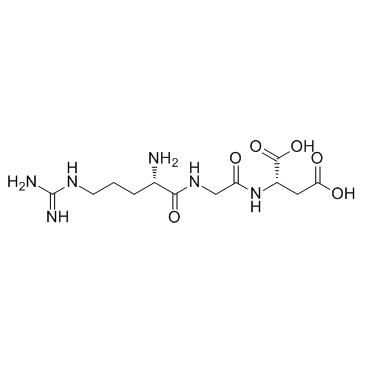H-Arg-Gly-Asp-OH

H-Arg-Gly-Asp-OH structure
|
Common Name | H-Arg-Gly-Asp-OH | ||
|---|---|---|---|---|
| CAS Number | 99896-85-2 | Molecular Weight | 346.340 | |
| Density | 1.6±0.1 g/cm3 | Boiling Point | N/A | |
| Molecular Formula | C12H22N6O6 | Melting Point | 153-155℃ (ethyl ether ) | |
| MSDS | Chinese USA | Flash Point | N/A | |
|
Coculture of dorsal root ganglion neurons and differentiated human corneal stromal stem cells on silk-based scaffolds.
J. Biomed. Mater. Res. A 103 , 3339-48, (2015) Corneal tissue displays the highest peripheral nerve density in the human body. Engineering of biomaterials to promote interactions between neurons and corneal tissue could provide tissue models for nerve/cornea development, platforms for drug screening, as w... |
|
|
Inducing cells to disperse nickel nanowires via integrin-mediated responses.
Nanotechnology 26(13) , 135102, (2015) We present non-cytotoxic, magnetic, Arg-Gly-Asp (RGD)-functionalized nickel nanowires (RGD-nanowires) that trigger specific cellular responses via integrin transmembrane receptors, resulting in dispersal of the nanowires. Time-lapse fluorescence and phase con... |
|
|
Improved tumor-targeting MRI contrast agents: Gd(DOTA) conjugates of a cycloalkane-based RGD peptide.
Biochem. Biophys. Res. Commun. 455(3-4) , 246-50, (2014) Two new MRI contrast agents, Gd-DOTA-c(RGD-ACP-K) (1) and Gd-DOTA-c(RGD-ACH-K) (2), which were designed by incorporating aminocyclopentane (ACP)- or aminocyclohexane (ACH)-carboxylic acid into Gd-DOTA (gadolinium-tetraazacyclo dodecanetetraacetic acid) and cy... |
|
|
Metabolomic serum profiling detects early-stage high-grade serous ovarian cancer in a mouse model.
J. Proteome Res. 14(2) , 917-27, (2015) Ovarian cancer is a deadly disease killing more than any other gynecologic cancer. Nonspecific symptoms, combined with a lack of early detection methods, contribute to late diagnosis and low five-year survival rates. High-grade serous carcinoma (HGSC) is the ... |
|
|
Quantitative high throughput screening using a primary human three-dimensional organotypic culture predicts in vivo efficacy.
Nat. Commun. 6 , 6220, (2015) The tumour microenvironment contributes to cancer metastasis and drug resistance. However, most high throughput screening (HTS) assays for drug discovery use cancer cells grown in monolayers. Here we show that a multilayered culture containing primary human f... |
|
|
The gadolinium-based contrast agent Omniscan® promotes in vitro fibroblast survival through in situ precipitation.
Metallomics 7 , 1103-10, (2015) The current study aims to explore how the gadolinium (Gd)-based contrast agent (GBCA) Omniscan® enhanced cell viability of murine fibroblasts. The results of scanning electron microscopy showed that Omniscan® can precipitate in cell culture media and deposit ... |
|
|
Disruption of integrin-fibronectin complexes by allosteric but not ligand-mimetic inhibitors.
Biochem. J. 464(3) , 301-13, (2014) Failure of Arg-Gly-Asp (RGD)-based inhibitors to reverse integrin-ligand binding has been reported, but the prevalence of this phenomenon among integrin heterodimers is currently unknown. In the present study we have investigated the interaction of four diffe... |
|
|
Interventions for treating leg ulcers in people with sickle cell disease.
Cochrane Database Syst. Rev. 12 , CD008394, (2014) The frequency of skin ulceration makes it an important contributor to the morbidity burden in people with sickle cell disease. Many treatment options are available to the healthcare professional, although it is uncertain which treatments have been assessed fo... |
|
|
Synchrotron X-ray fluorescence studies of a bromine-labelled cyclic RGD peptide interacting with individual tumor cells.
J. Synchrotron Radiat. 20(Pt 2) , 226-33, (2013) The first example of synchrotron X-ray fluorescence imaging of cultured mammalian cells in cyclic peptide research is reported. The study reports the first quantitative analysis of the incorporation of a bromine-labelled cyclic RGD peptide and its effects on ... |
|
|
Isotopic tracing for calculating the surface density of arginine-glycine-aspartic acid-containing peptide on allogeneic bone.
Orthop. Surg. 5(1) , 51-5, (2013) To investigate the feasibility of determining the surface density of arginine-glycine-aspartic acid (RGD) peptides grafted onto allogeneic bone by an isotopic tracing method involving labeling these peptides with (125) I, evaluating the impact of the input co... |